It’s not every day a Swiss startup crashes the party and walks out with the cool kids, the pros, and Wall Street all in its corner. Yet that’s exactly what On has done.
Slipping into a category dominated by billion-dollar beasts and somehow convincing everyone from city-run-club rookies to Roger Federer that its “clouds” are worth the climb. In a flattening sneaker market, On keeps posting outsized growth, proof that its marketing is doing more than selling shoes.
It’s a winning game plan with premium positioning holding the defensive line, a cultural charm offensive driving the attack, and channel discipline keeping control of the field.
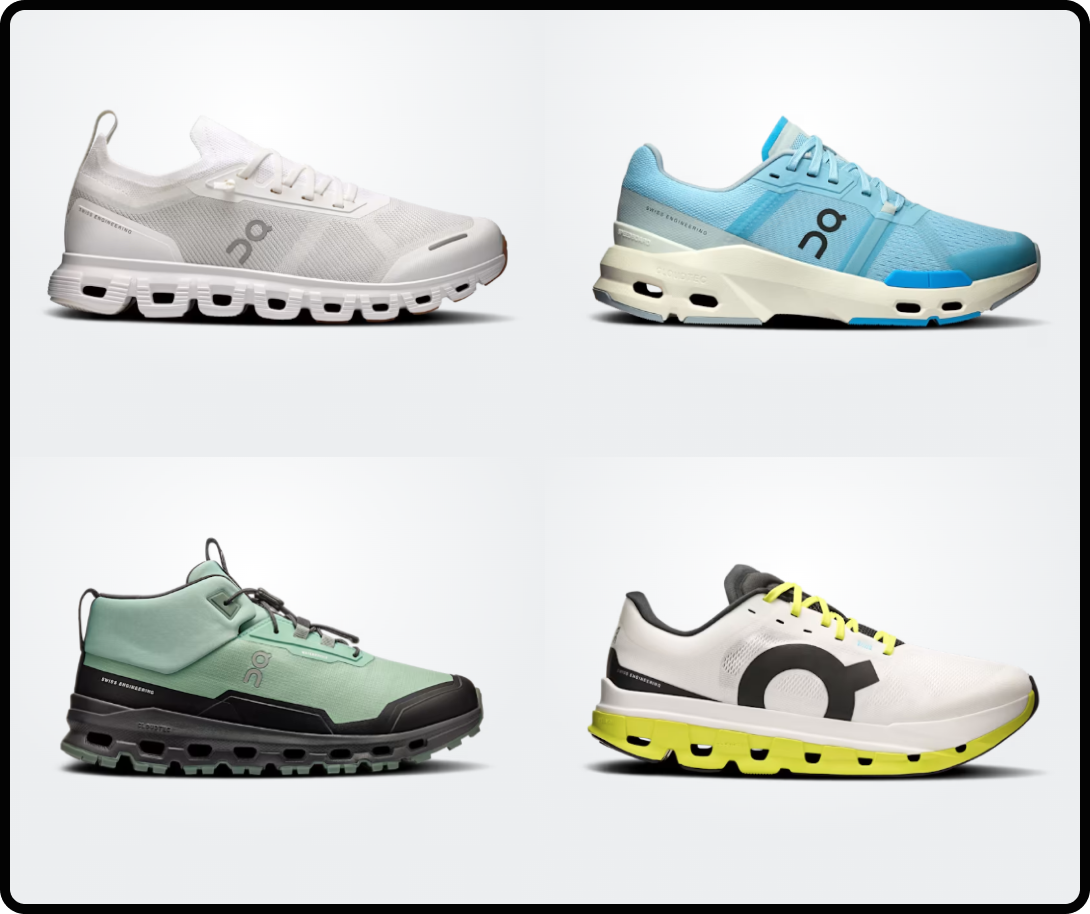
In this strategy analysis, we’ll trace how On built its momentum, dissect its community and creative plays, unpack its athlete partnerships, and see how its strategy stacks up against the competition.
On the Rise: From Swiss Startup to Global Breakout
On was launched in 2010 in Zurich by former Swiss professional triathlete, Olivier Bernhard, and his friends David Allemann and Caspar Coppetti. Their mission? To reinvent running with a radically different cushioning technology.
Their first breakthrough came with the CloudTec® sole; a unique, cloud-like architecture that on one hand (or foot, I should say) improved performance but also gained massive visibility, becoming instantly recognizable on shelves and social media.
By 2014, On had entered the U.S. market and opened flagship stores in New York, London, and other key running hubs in hopes to lay the foundation for fruitful global presence. The brand truly skyrocketed after its 2021 NYSE listing (and with Roger Federer joining as both investor and partner), bringing mainstream awareness alongside technical credibility.
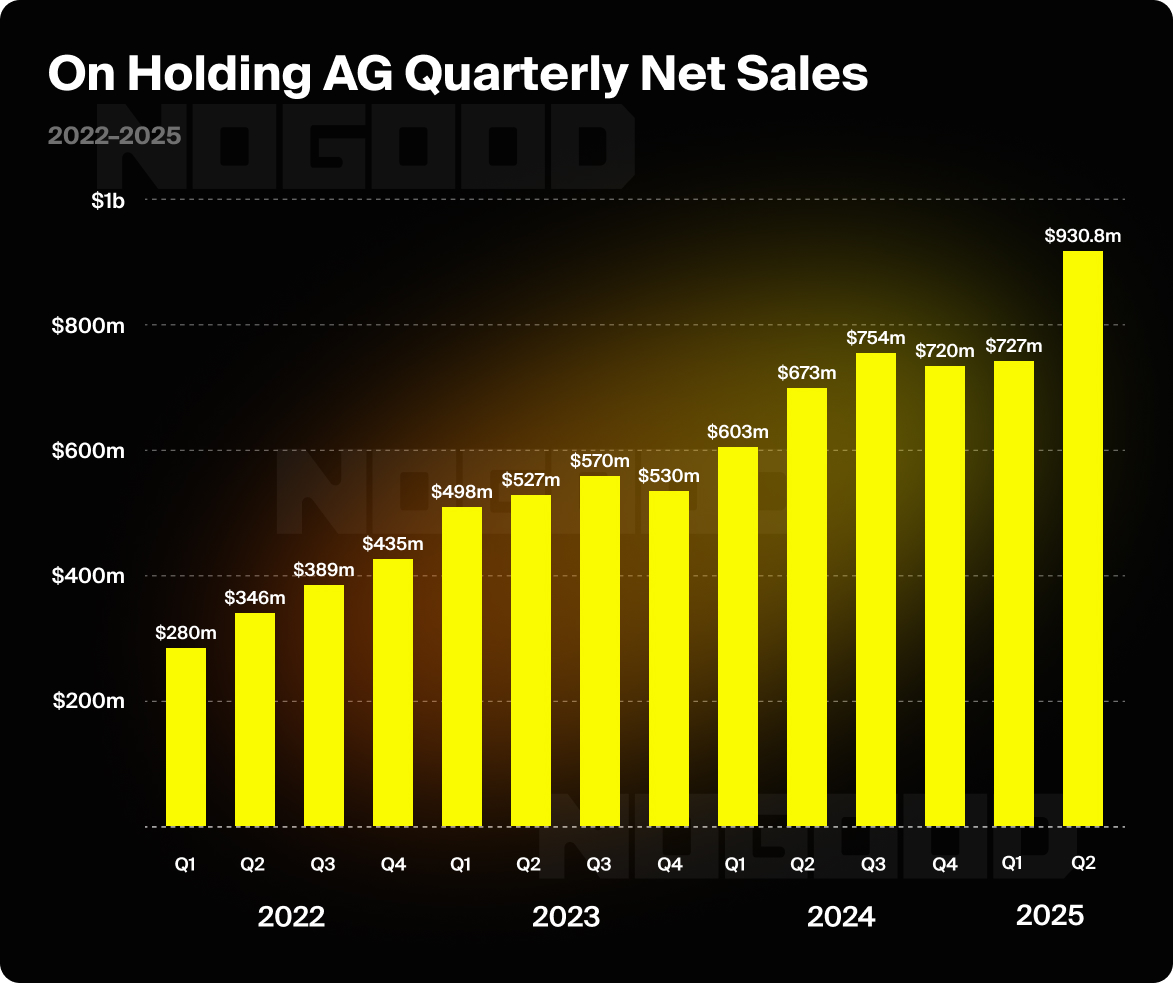
On’s marketing strategy has translated into measurable business results:
- 2024 Annual Revenue: CHF 2.32 billion (Swiss francs), up 29.4% from 2023, showing that brand storytelling, DTC growth, and selective wholesale are driving meaningful sales increases.
- 2025 Q2 Revenue: CHF 749.2 million, a 32% year-over-year increase, highlighting continued momentum across regions.
- Stock Performance (NYSE: ONON, Aug 13, 2025): $48.08 per share, up 10% after Q2 earnings, reflecting investor confidence in the brand’s marketing-led growth strategy.
Today, On continues to outpace the athletic market, posting double-digit growth across regions, proof that its rise from a Swiss startup to a global brand is a case study in scaling visibility while carefully curating brand image.
Premium Performance With Personality
On’s roots in Switzerland give the brand an inherent perception of precision, engineering rigor, and quality. Switzerland is globally associated with technical excellence. Think Swiss watches or high-performance engineering. On leverages this cultural association in its storytelling (positioning).
The CloudTec® sole, the patented cushioning system, is functional and framed as a piece of engineered Swiss innovation. This gives the brand more authenticity entering into the battle of performance footwear. This “precision first” mindset reassures serious runners that the shoes are technically sound, reliable, and designed for measurable improvement.
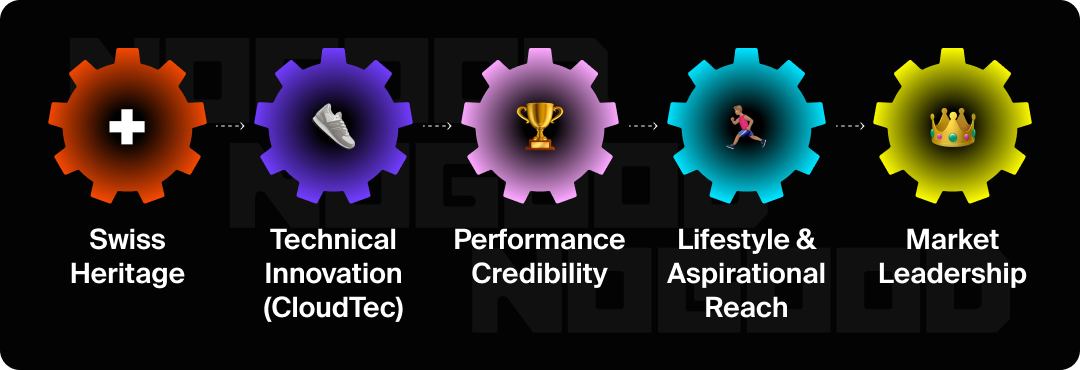
On pairs this technical rigor with elevated, aspirational, and effortlessly stylish lifestyle cues. Sleek, minimalist colorways; campaigns featuring real-world runners; and social content that’s optimistic, playful, and inclusive. This brand marketing decision turns On into more a statement of taste, culture, and everyday vitality.
In 2025, the ability to engage both elite, performance-driven athletes and discerning, style-conscious consumers represents a strategically ambitious undertaking. Yet it allows On to maintain a commanding position within the category, establishing a hierarchy that few competitors can replicate. This demonstrates that technical excellence and cultural relevance can coexist without compromise.
Creative Strategy: Distinctive, Human & Culturally Aware
On’s creative philosophy orbits around “soft performance”. This messaging is meant to resonate across skill levels, welcoming newcomers to running (or exercise at large) while still earning respect from elite runners. This approach allows the brand to celebrate movement and wellness without defaulting to the hyper-aggressive, ego-driven tone often seen in the performance running category.
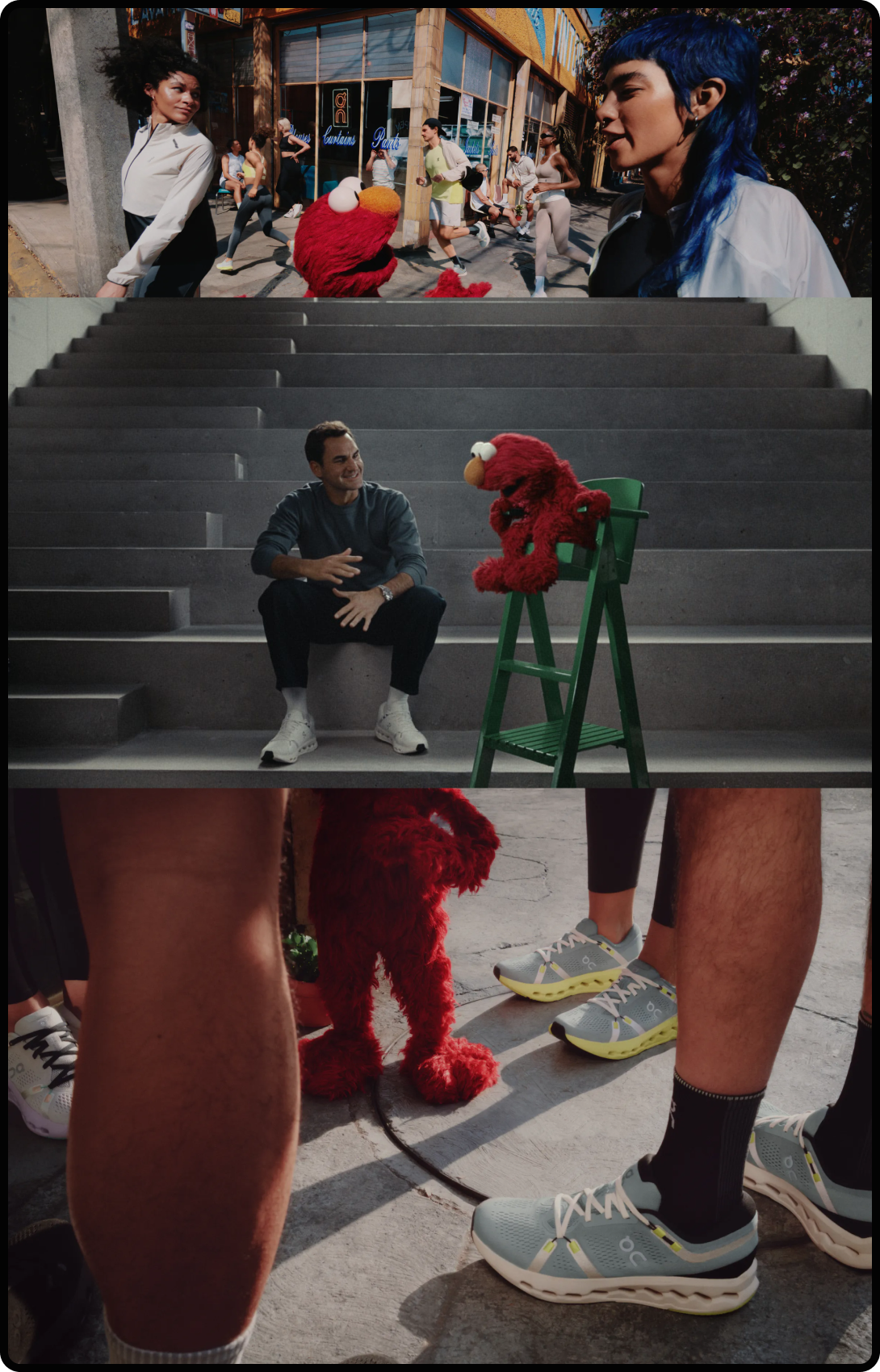
On + Sesame Street = Soft Wins
A prime example is their Soft Wins campaign featuring Elmo. By fusing Sesame Street’s universal nostalgia with the wellness and motivation of running, On created content that was immediately shareable and culturally relevant. Social clips went viral, memes proliferated, and lifestyle adoption extended beyond traditional runners, all without undercutting technical credibility.
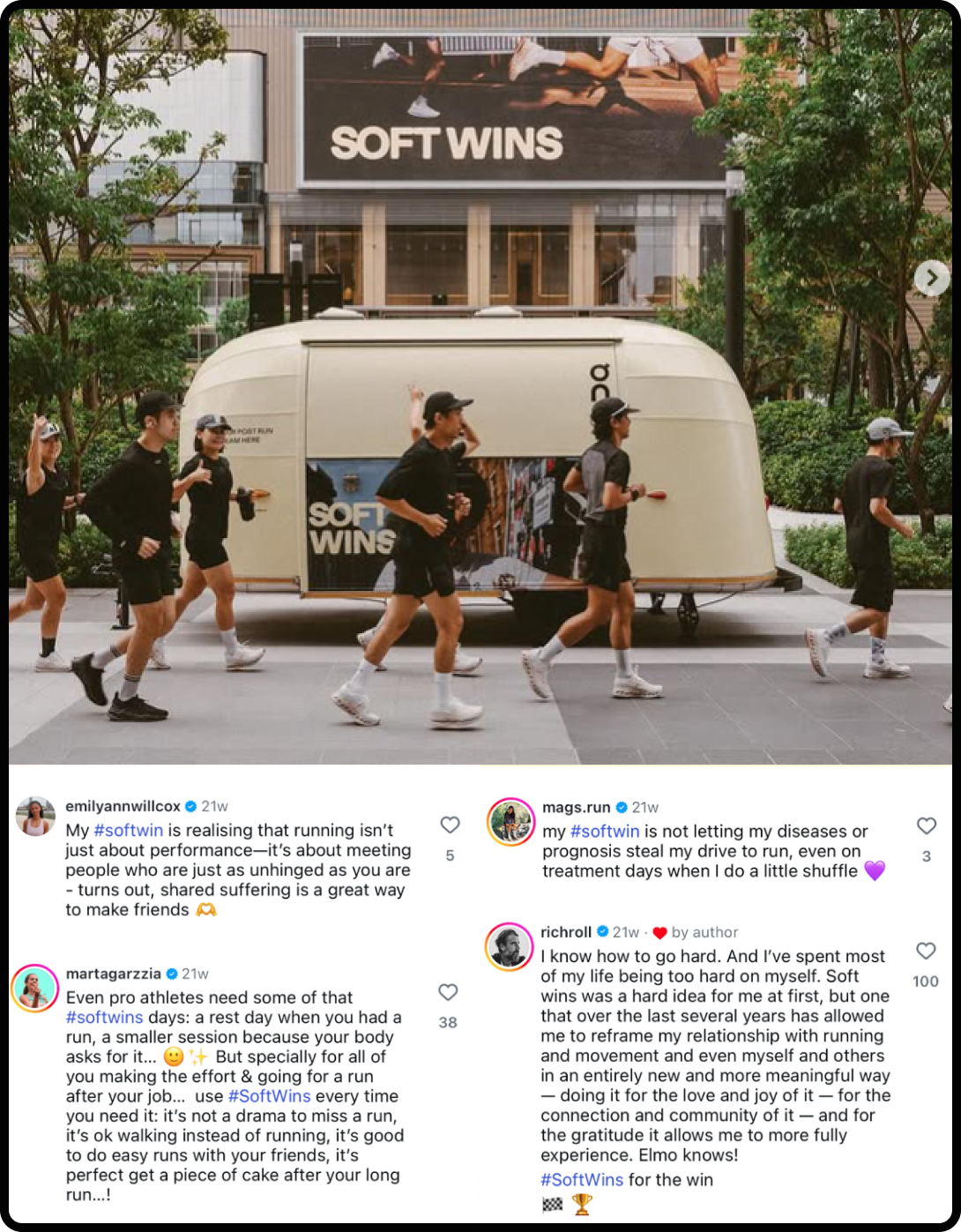
But what made Soft Wins especially powerful was how it invited the community into the creative. Runners became co-creators. User-generated content flooded social feeds as people tweeted and/or filmed their own “Soft Wins” moments of relatable training struggles or sentiment from support systems. By leaning into UGC, On amplified the campaign’s reach organically and gave runners a chance to see themselves reflected in the brand story. This participatory layer didn’t just boost engagement metrics; it reinforced On’s positioning as a brand that listens to and builds with its community, not just for them.
Running for Each Other
Another notable campaign, “Run for Each Other,” aimed to emphasize community and mutual support among runners by showcasing diverse groups running together.
If you’re a runner, or athlete of any kind, you know just how much you’re forced to battle physical and mental pain. Sore muscles, blisters, fatigue, and the constant push against personal limits but, these hardships are universally understood within the running community, creating an unspoken bond that transcends demographics, geography, and skill level. A beginner finishing their first 5K feels the same triumph and vulnerability that an elite marathoner experiences at Mile 20.
The campaign showcased the power of collective effort and the shared highs and lows of running, reinforcing that while On is a performance brand, it’s simultaneously a catalyst for connection, inclusivity, and a deeply engaged community where every runner’s journey matters.
By layering in humor, warmth, and cultural references, campaigns like Soft Wins move far beyond product promotion, they tap into everyday human moments that runners (and non-runners alike) want to share. The integration of UGC only magnified this effect, transforming the campaign from a top-down message into a bottom-up cultural wave. On’s ability to engineer content for relatability and keep the brand voice authentic ensures that their storytelling resonates across TikTok, Instagram, and beyond. The result is a marketing strategy that creates belonging, builds community touchpoints, and reinforces a unified brand personality across every interaction.
Community & Experiential Marketing: Run Clubs as Growth Engines
Today’s most relevant brands understand that “community” isn’t just a buzzword you can throw around; it’s a cultural currency. To stand out, companies must approach the community not as a single channel but as a multi-dimensional ecosystem that blends digital, physical, and emotional connection points. This has led many to double down on experiential activations, giving consumers something tangible to belong to rather than simply something to buy.
On exemplifies this shift through its global network of run clubs. More than a fitness meet-up, these gatherings function as cultural hubs, particularly for Gen Z and millennials in urban centers, where running has exploded as both a wellness habit and social identity marker. By leaning into this movement as an authentic participant (not a top-down sponsor), On embeds itself directly into the fabric of modern community culture.
Why it matters: Run clubs fuse brand experience with human connection in ways digital content alone cannot. They transform casual customers into loyal members through shared rituals, they tap into the psychology of belonging and identity, and they build durable relationships that extend well beyond a single transaction.
On’s playbook for run clubs includes:
- Weekly sessions hosted from flagship stores and partner retailers.
- Staff and ambassadors leading warmups, pacing, and integrating live try-ons + gait analysis.
- Content capture (routes, photos, recap videos) shared across Strava, TikTok, and Instagram.
- Conversion effects: low-barrier trials lead to same-day sales and heightened purchase intent.
- CRM impact: participant data fuels personalized follow-ups, product recommendations, and future event invites.
- Influencers and micro-creators amplify the experience digitally, scaling reach far beyond the physical run.
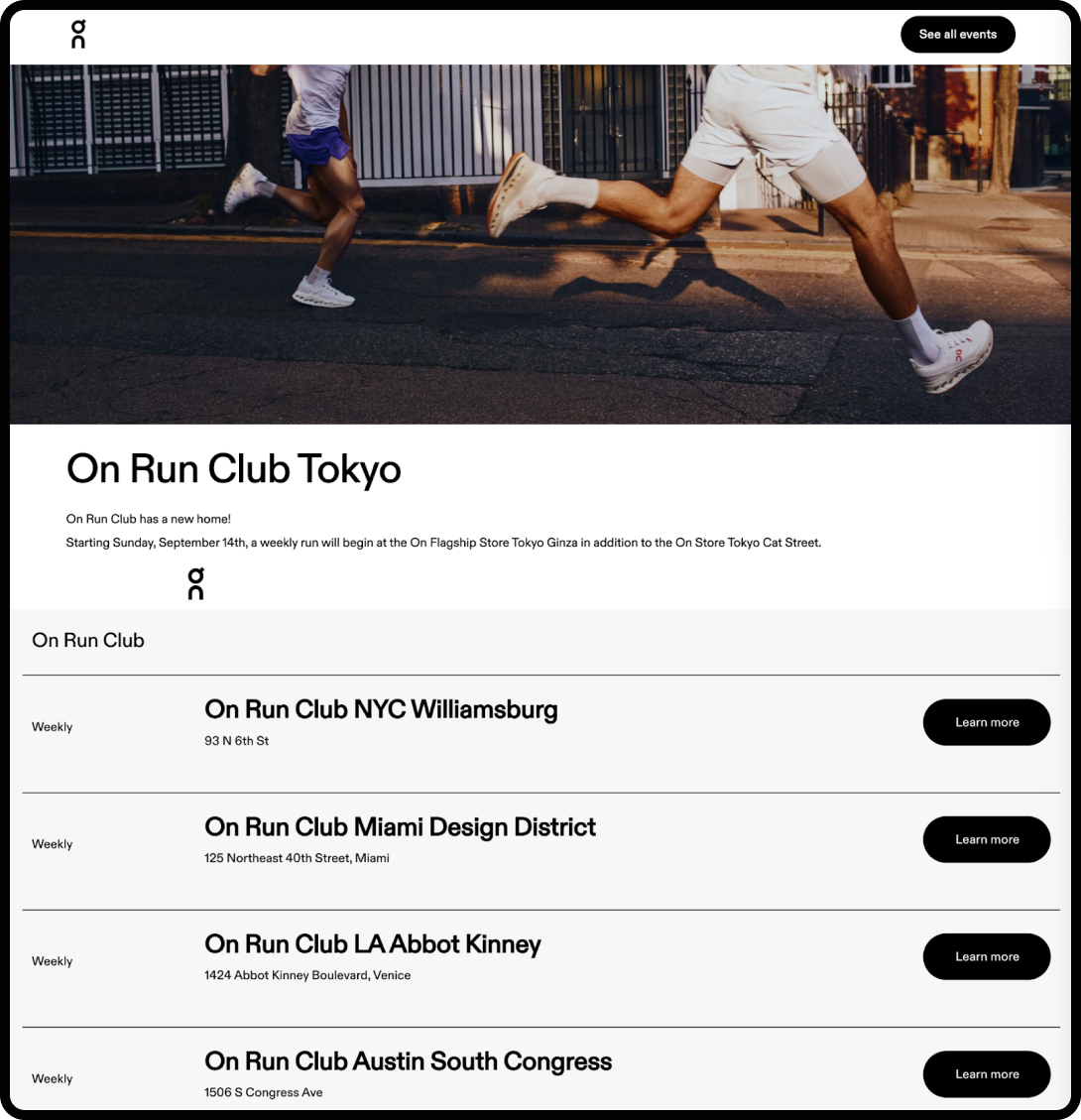
The result is a growth engine that is equal parts marketing, sales, and community-building. For On, run clubs don’t just drive trials; they cement the brand as a cultural participant in the everyday lives of runners, earning loyalty through belonging rather than advertising.
Partnerships & Athlete Strategy
On’s athlete strategy is not built on star power alone. Quite frankly, the starpower of athlete partnerships can often come across unrelatable and uninspiring to the average consumer. On’s strategy, however, is carefully curated to span different tiers of influence, disciplines, and cultural touchpoints, ensuring technical credibility in elite competition while remaining accessible and fashionable to everyday runners.
The most high-profile partnership is, of course, with Roger Federer. Unlike traditional athlete endorsements, Federer became both an equity investor and product collaborator, working directly on the design of the Roger Pro tennis shoe.
This dual role gave him skin in the game and allowed On to leverage his unmatched (no pun intended) reputation for precision and longevity. His involvement instantly legitimized On within the wildly growing sport of tennis and across the sports industry at large, all while attracting business and lifestyle press coverage.
At the same time, On provided Federer a runway to extend his legacy into entrepreneurship and innovation, serving (once again, no pun intended) as a cornerstone of his influence off the court as a visionary leader shaping the future of performance gear.
But Federer is only one set in the match. Crucial, but the whole story takes many wins. On’s roster spans elite track and field athletes, long-distance runners, extreme hikers, tennis players, and increasingly, community leaders and grassroots athletes.Olympic sprinters and marathoners validate the performance side of the product, while everyday run club leaders and micro-influencers extend the brand into culture, authenticity, and community-building. This dual approach means On shows up in both headline-grabbing global moments (like the Austin Marathon or the US Open) and hyper-local activations (weekly run clubs and regional races).
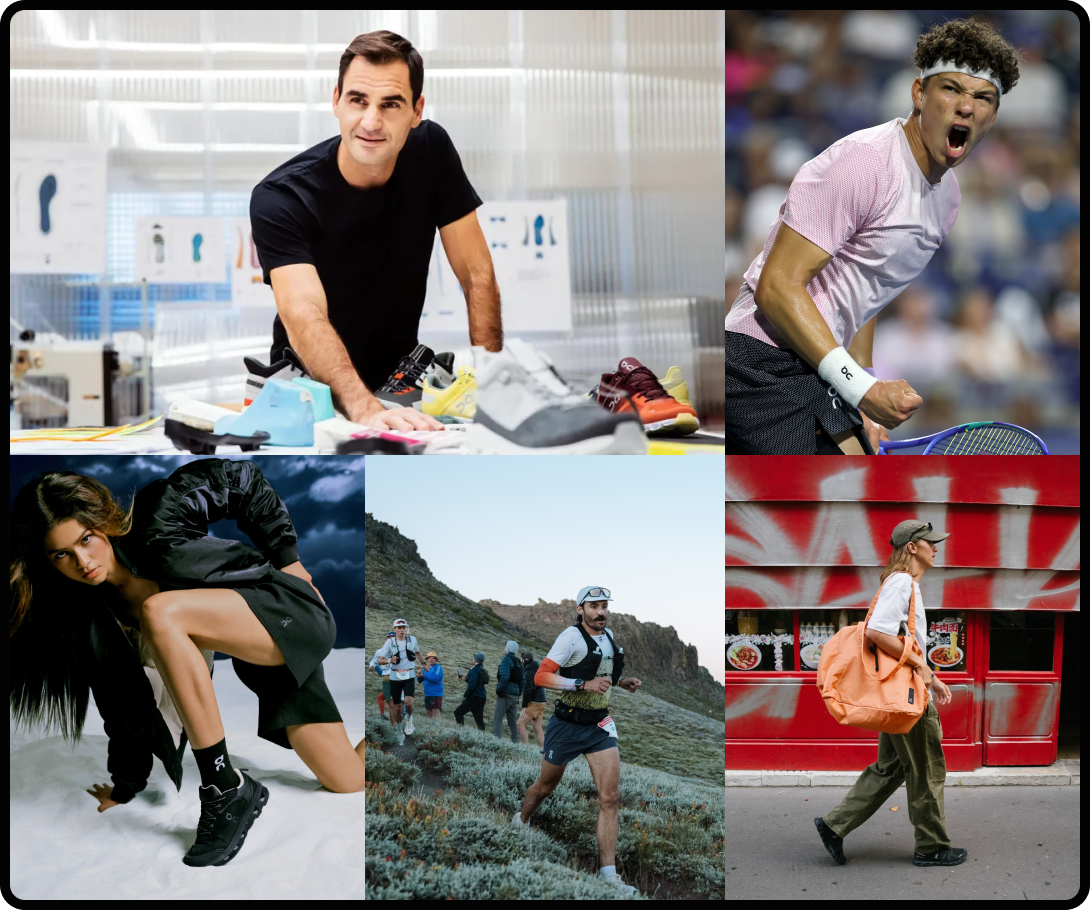
Crucially, On is intentional about how they communicate and act on their values. Their athlete partners are chosen as much for their reputations off the track as on it. Wholesome, optimistic, full of integrity, and collaborative figures who embody the brand’s “optimistic performance” ethos. This brand-safe approach differentiates On from competitors who occasionally risk polarizing or controversial endorsements.
Together, this multi-layered athlete strategy creates breadth (across sports and geographies) and depth (from grassroots to global icons), ensuring the brand’s credibility resonates with every level of consumer, from the first-time 5K runner to the elite Olympic qualifier.
Measurement & Optimization
On’s growth engine isn’t left to intuition; it’s constantly measured and refined:
- At the brand level, metrics like unaided awareness, social share of voice, and distinctive asset recall gauge cultural resonance.
- On the commercial side, the team tracks DTC mix percentages, repeat purchase behavior, and CRM engagement, ensuring that community initiatives translate into lasting customer value.
- Events and run clubs are assessed through a conversion funnel: attendance → trial → purchase, to quantify ROI beyond surface-level buzz.
- Creative performance is benchmarked against control groups to isolate engagement lift and organic reach impact.
- Finally, global KPIs balance growth across regions (e.g., +24% in the Americas, +42% in EMEA), allowing spend to shift dynamically with market momentum.
Together, these measurements ensure that On is growing smart, just as fast. In such a competitive market, every creative choice and community investment must be tied back to measurable impact and long-term brand equity.
Competitive Context
The running and performance footwear market is saturated with giants like Nike, Adidas, and emerging challengers like Hoka, each vying for cultural relevance and consumer loyalty. Nike and Adidas continue to dominate on sheer scale, leveraging global endorsement rosters and iconic campaigns that are intimidating to compete against.
Yet, their size often slows their ability to innovate culturally within running alone. What once felt revolutionary can now feel formulaic. Their storytelling still leans heavily on performance bravado and athlete heroics, sometimes missing the more “average” human and community-driven narratives resonating with younger consumers.
Hoka, by contrast, has carved a niche with its maximalist cushioning story and grassroots community building (similar to On). Its positioning as the “comfort-first” brand resonates with endurance athletes and everyday runners alike, and its run clubs and event strategy drive strong community engagement. However, Hoka has yet to fully bridge into broader lifestyle appeal, the shoes remain functional-first, limiting cultural adoption beyond performance-only contexts.
On’s edge lies in how it has fused performance credibility with cultural momentum:
- Its ownable visual identity (clean, minimalist Swiss design) sets it apart on a crowded footwear shelf.
- Its premium channel mix, positions it closer to lifestyle and fashion retailers than purely performance shelves, expanding its reach into aspirational audiences.
- Creative campaigns like Soft Wins and Run for Each Other show On’s ability to blend emotions in a way that neither Nike’s hero worship nor Hoka’s comfort-first narratives fully achieve.
Layer in the Federer halo effect, a mix of investor credibility, media coverage, and athlete association, and On has elevated its brand story far beyond product specs.
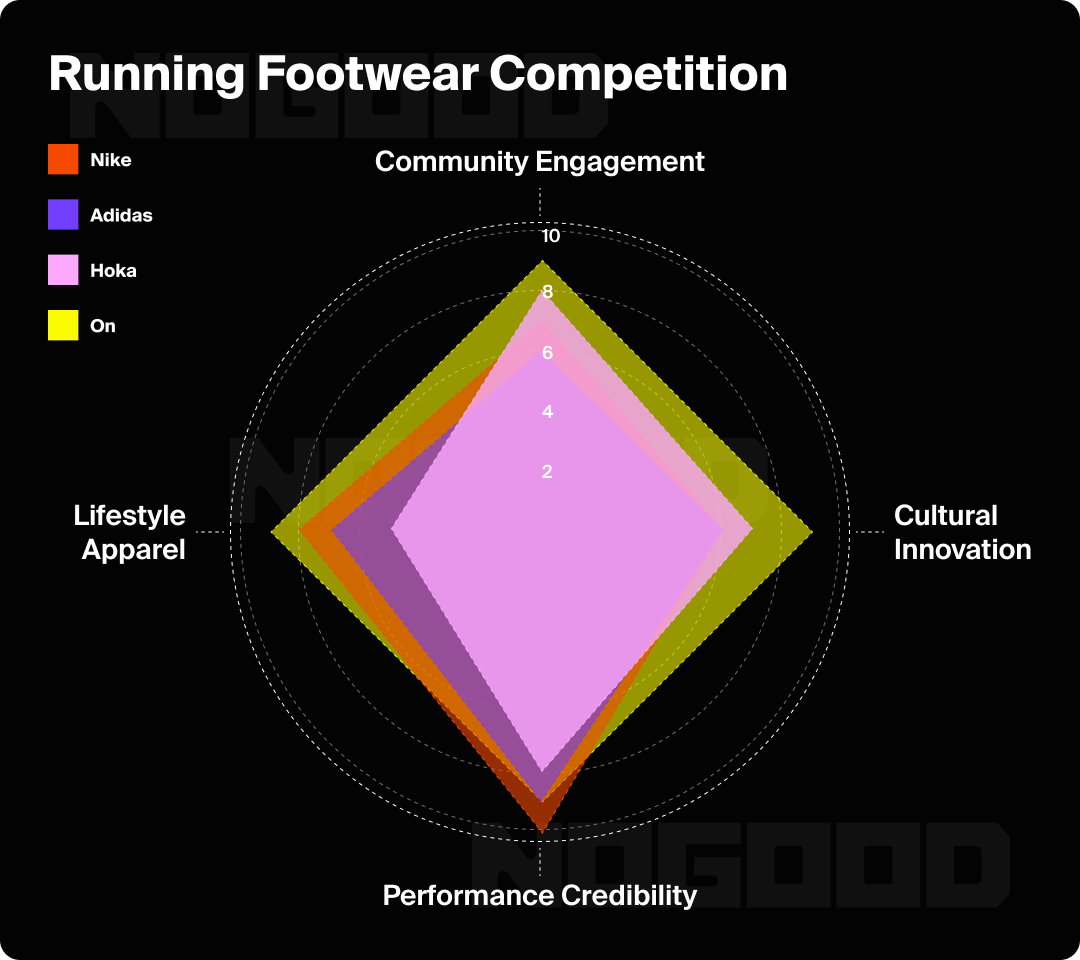
The risk is clear: competitors are watching. Nike and Adidas have the resources to imitate community-driven tactics, while Hoka could double down on lifestyle crossover. For On, the path forward will be about refreshing tone, innovating experiences, and staying ahead of imitation, ensuring the brand feels not only current but leading in how performance and culture intersect.
Final Thoughts: The Human Edge
At the end of the day, On’s marketing strategy has less to do with selling shoes and more to do with redefining what a modern performance brand looks like. By blending cultural fluency, community-first activations, and a carefully curated athlete strategy, On has built a brand that resonates as much on TikTok and Strava as it does at the starting line of a marathon or first serve of a match.
Competitors may have scale, but On has agility, authenticity, and a storytelling edge that keeps it ahead. The lesson is clear for marketers: product function sets the baseline, but cultural relevance and human connection are what turn a rally into a winning point or a sprint into the finish line.







